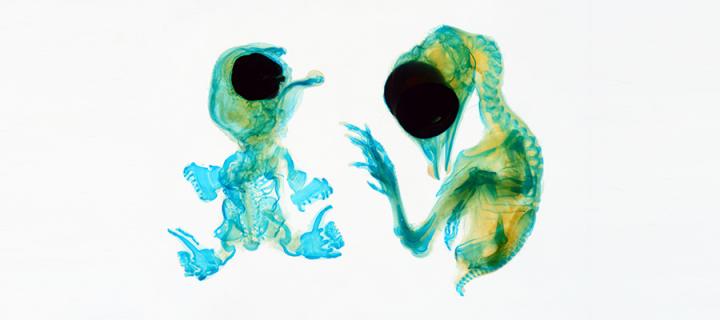talpid3
talpid3 mutants are classical recessive embryonic lethal chicken mutants with abnormal limb patterning and malformations.
This line is only available as cryopreserved material.
Summary
talpid3 mutants are classical recessive embryonic lethal chicken mutants with abnormal limb patterning and malformations in other regions of the embryo known to depend on Hedgehog signalling (limb, face, brain, neural tube, liver, lungs, gut, feathers, bone)1,2,9. talpid3 chick embryos exhibit abnormal centrosomes and a subsequent failure of ciliogenesis3–5. Other phenotypes include vascular abnormalities2, cell polarity and cell migration defects, for example in the hair cells of the inner ear, growth plates of the bone6 and the neural crest. Therefore, the talpid3 line can be used to elucidate Hedgehog signalling and the role of centrosome and cilia in embryonic development and disease.

Utility
The talpid3 mutation in the chicken was mapped to a frameshift mutation in the TALPID3 gene, a homologue of the human KIAA0586 gene, and is predicted to cause a truncated protein with no function7. TALPID3/KIAA0586 is a centrosomal protein, which is essential for ciliogenesis7. As cilia are essential for normal transduction of the Hedgehog signalling pathway, talpid3 embryos lack both normal centrosome function, cilia and have abnormal Hedgehog signalling. Knockout mouse analysis shows that the function is conserved between birds and mammals8 (gene name in the mouse - Talpid3).
The developing chicken limb is a classical model in developmental biology which has been used to understand the genetic basis of vertebrate development. Insights from chicken mutants such as talpid3 have provided direct insights into clinical genetics and specifically the genes responsible for limb abnormalities and ciliopathies in humans9. For example, mutations in the KIAA0586 gene in humans cause the ciliopathy syndromes Joubert syndrome 23 (OMIM #616490) and Short-rib thoracic dysplasia 14 with polydactyly (OMIM #616546)10.
Line origin
The Roslin talpid3 chicken line is maintained in our conventional unit on an outbred white Leghorn background. The talpid3 mutant was first discovered by Dr Donald Ede at Wye College, Sussex11,12.
Publications
- Davey, M. G. et al. The chicken talpid3 gene encodes a novel protein essential for Hedgehog signaling. Genes Dev. 20, 1365–1377 (2006).
- Davey, M. G., James, J., Paton, I. R., Burt, D. W. & Tickle, C. Analysis of talpid3 and wild-type chicken embryos reveals roles for Hedgehog signalling in development of the limb bud vasculature. Dev. Biol. 301, 155–165 (2007).
- Davey, M. G., McTeir, L., Barrie, A. M., Freem, L. J. & Stephen, L. A. Loss of cilia causes embryonic lung hypoplasia, liver fibrosis, and cholestasis in the talpid3 ciliopathy mutant. Organogenesis 10, 177–185 (2014).
- Stephen, L. A. et al. Failure of centrosome migration causes a loss of motile cilia in talpid3 mutants. Dev. Dyn. 242, 923–931 (2013).
- Cruz, C. et al. Foxj1 regulates floor plate cilia architecture and modifies the response of cells to sonic hedgehog signalling. Development 137, 4271–4282 (2010).
- MacRae, V. E. et al. Inhibition of PHOSPHO1 activity results in impaired skeletal mineralization during limb development of the chick. Bone 46, 1146–1155 (2010).
- Yin, Y. et al. The Talpid3 gene (KIAA0586) encodes a centrosomal protein that is essential for primary cilia formation. Development 136, 655–664 (2009).
- Bangs, F. et al. Generation of mice with functional inactivation of talpid3, a gene first identified in chicken. Development 138, 3261–3272 (2011).
- Davey, M. G., Towers, M., Vargesson, N. & Tickle, C. The chick limb: Embryology, genetics and teratology. Int. J. Dev. Biol. 62, 253–263 (2018).
- Fraser, A. M. & Davey, M. G. TALPID3 in Joubert syndrome and related ciliopathy disorders. Current Opinion in Genetics and Development 56, 41–48 (2019).
- Ede, D. A. & Kelly, W. A. Developmental abnormalities in the head region of the talpid3 mutant of the fowl. J. Embryol. Exp. Morphol. 12, 161–182 (1964).
- Ede, D. A. & Kelly, W. A. Developmental abnormalities in the trunk and limbs of the talpid3 mutant of the fowl. J. Embryol. Exp. Morphol. 12, 339–356 (1964).


